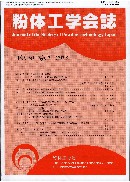All issues

Volume 50, Issue 11
Displaying 1-4 of 4 articles from this issue
- |<
- <
- 1
- >
- >|
Original Paper
-
Toshio Yamamoto, Akihiko Suda2013Volume 50Issue 11 Pages 784-789
Published: November 10, 2013
Released on J-STAGE: December 26, 2013
JOURNAL FREE ACCESSSpinel structure MgA12O4 is an important compound oxide for de-sulfur catalysts or electronic devices. There had been proposed so many-kinds of synthesis routes for MgAl2O4, however, it is still very difficult to get a pure and stoichiometric MgAl2O4 powder with high specific surface area. The authors approached by using atmospheric solvothermal synthesis with mixed nitrate solution adding monomer, dimer and trimer of glycol. The MgAl2O4 powder was successfully synthesized by the process and the glycols were recognized to play an important role of the reduction agent of nitric acid group to deposit uniform precursor.View full abstractDownload PDF (562K) -
Kazunori Kadota, Yoshiyuki Shirakawa, Kazuki Gonda, Shuto Murata, Yuic ...2013Volume 50Issue 11 Pages 790-796
Published: November 10, 2013
Released on J-STAGE: December 26, 2013
JOURNAL FREE ACCESSLiquid-liquid interfacial crystallization has been proposed as a novel crystallization process. This method enables us to crystallize solute materials at normal and constant temperature without heating or cooling. The applications of this method in medicine and food science can be expected. As reported in our previous paper, it was possible to produce porous particles by forming droplet interfaces in developed atomizing crystallization.
In this study, a fabrication of organic/inorganic composite particles by atomizing crystallization has been conducted. The silica was used as a core particle and the glycine was used as a coating substance. The interface between glycine solution and organic solvent was formed on the silica particle by wetting the silica surface with glycine solution. The glycine / silica particles were produced since glycine crystals were precipitated on the silica surface by atomizing crystallization. The effect of organic solvent on the mean particle size of composite particles was in the order of 1-butanol > 2-methyl-1-propanole > 2-butanone > 2-butanol. The unstable β-glycine could be precipitated by the liquid-liquid interfacial crystallization, and transformation from the unstable β-glycine to the metastable α-glycine occurred by solution-mediated transformation.
View full abstractDownload PDF (1556K)
Review
-
Yasuhisa Ouchi, Takafumi Seto2013Volume 50Issue 11 Pages 797-802
Published: November 10, 2013
Released on J-STAGE: July 04, 2014
JOURNAL RESTRICTED ACCESSRecent advance in the laser ablation techniques enables us to synthesize various nanostructured materials. In particular, composite nanoparticles are considered as building blocks for various nanostructured materials. In this review article, recent studies on synthesis of composite nanoparticles using laser ablation are introduced. Various types of composite nanoparticles, such as core-shell, patch, and anisotropic particles, are synthesized by one-step process by laser irradiation of multi-component solid targets. Some typical examples of generated composite are also introduced.View full abstractDownload PDF (684K)
Review: Practical Environmental Technology Series
-
Haruo Izumi, Ryuichiro Kamimura2013Volume 50Issue 11 Pages 803-808
Published: November 10, 2013
Released on J-STAGE: July 04, 2014
JOURNAL RESTRICTED ACCESSLIQUID GAS CO. LTD liquefy and separate air into nitrogen, oxygen and argon with our power-saving and highly efficient plant, using liquefied natural gas (LNG : -162℃) which OSAKA GAS CO. LTD then receives as an ingredient of natural gas. Using liquid nitrogen (LN2 : -196℃) as the refrigerant, LIQUID GAS CO. LTD has successfully developed the powder processing service of cryogenic-grinding. In this process, the raw materials are cooled and/or frozen by LN2 to below brittle temperatures, where materials that are very difficult to grind at room temperature can be easily ground. Heat generation and oxidization are also restricted, so that the fundamental characteristics can be maintained. In addition, inactive LN2 enables the prevention of dust explosion.
Cryogenic-grinding reduces environmental loads in relation to the effective of LNG cold energy, and is a practical form of environmental engineering applicable to recycling and waste reduction. The purpose of this paper is to provide an outline of cryogenic-grinding, and provide specific examples of the potential applications.View full abstractDownload PDF (908K)
- |<
- <
- 1
- >
- >|